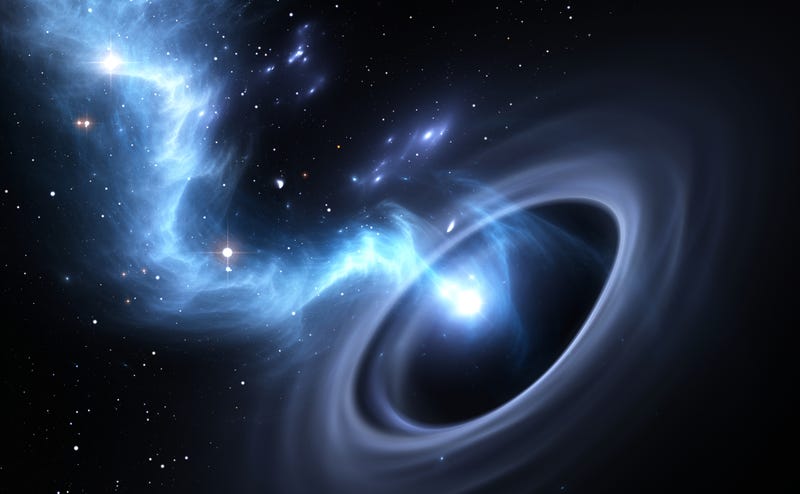
“There’s an invisible monster on the loose, barreling through intergalactic space so fast that if it were in our solar system, it could travel from Earth to the Moon in 14 minutes,” said NASA this week.
According to the space agency, this “monster” is a supermassive black hole that weighs as much as 20 million suns. It has also left behind a “never-before-seen 200,000-light-year-long ‘contrail’ of newborn stars, twice the diameter of our Milky Way galaxy.”
Where did it come from?
NASA said that the supermassive black hole now racing through outer space probably originated as the result of “a rare, bizarre game of galactic billiards,” among three other massive black holes.
Its history could span back around 50 million years, when astronomers think two galaxies merged and brought together two supermassive black holes at their centers. At some point, another galaxy came along, toting its own black hole.
“The three black holes mixing it up led to a chaotic and unstable configuration,” NASA explained. “One of the black holes robbed momentum from the other two black holes and got thrown out of the host galaxy.”
This singular black hole then took off while the other two went in the opposite direction.
“Rather than gobbling up stars ahead of it, like a cosmic Pac-Man, the speedy black hole is plowing into gas in front of it to trigger new star formation along a narrow corridor,” said NASA of the runaway black hole.
How did astronomers find it?
NASA’s Hubble Space Telescope “accidentally” captured the never-before-seen phenomenon, said astronomers.
“This is pure serendipity that we stumbled across it,” said Pieter van Dokkum of Yale University in New Haven, Conn., who was looking for globular star clusters in a nearby dwarf galaxy. “I was just scanning through the Hubble image and then I noticed that we have a little streak. I immediately thought, ‘oh, a cosmic ray hitting the camera detector and causing a linear imaging artifact.’ When we eliminated cosmic rays we realized it was still there. It didn’t look like anything we’ve seen before.”
Van Dokkum knew what he saw was weird, so his team did follow up research called a spectroscopy to analyze the energy of light with the W. M. Keck Observatories in Hawaii. They found that the trail following the black hole is indeed “very unusual,” and very bright.
His research led van Dokkum to determine that he was “looking at the aftermath of a black hole flying through a halo of gas surrounding the host galaxy.”
What is it up to?
So far, it looks as if the black hole is “streaking too fast to take time for a snack,” according to NASA. Instead, it has created new stars in its wake.
“We think we're seeing a wake behind the black hole where the gas cools and is able to form stars. So, we’re looking at star formation trailing the black hole,” said van Dokkum. “What we’re seeing is the aftermath. Like the wake behind a ship we’re seeing the wake behind the black hole.”
Researchers believe that the trail must be filled with many new stars since it is so bright. At the same time, the black hole at the end of the column stretches back to its parent galaxy.
“Gas in front of it gets shocked because of this supersonic, very high-velocity impact of the black hole moving through the gas. How it works exactly is not really known,” said van Dokkum.
There is still more research to be done regarding this rare find. Next, scientists plan to do follow-up observations with NASA’s James Webb Space Telescope and the Chandra X-ray Observatory to confirm that it is a black hole. With the upcoming Nancy Grace Roman Space Telescope from NASA, which will have a wide-angle view of the universe, more of these “star streaks” may be found in the future.


